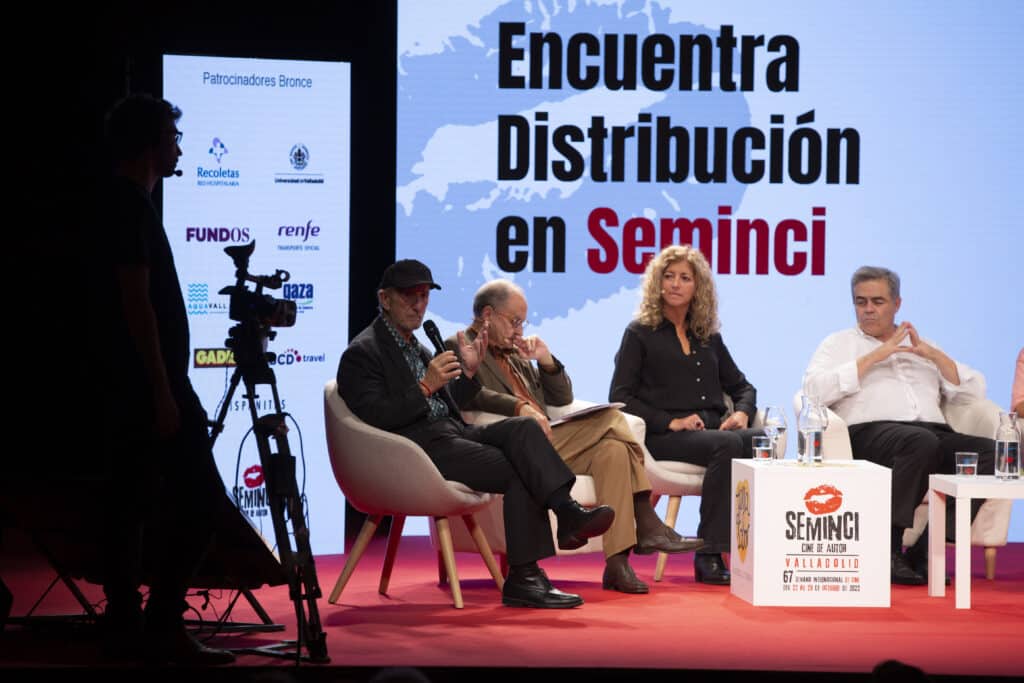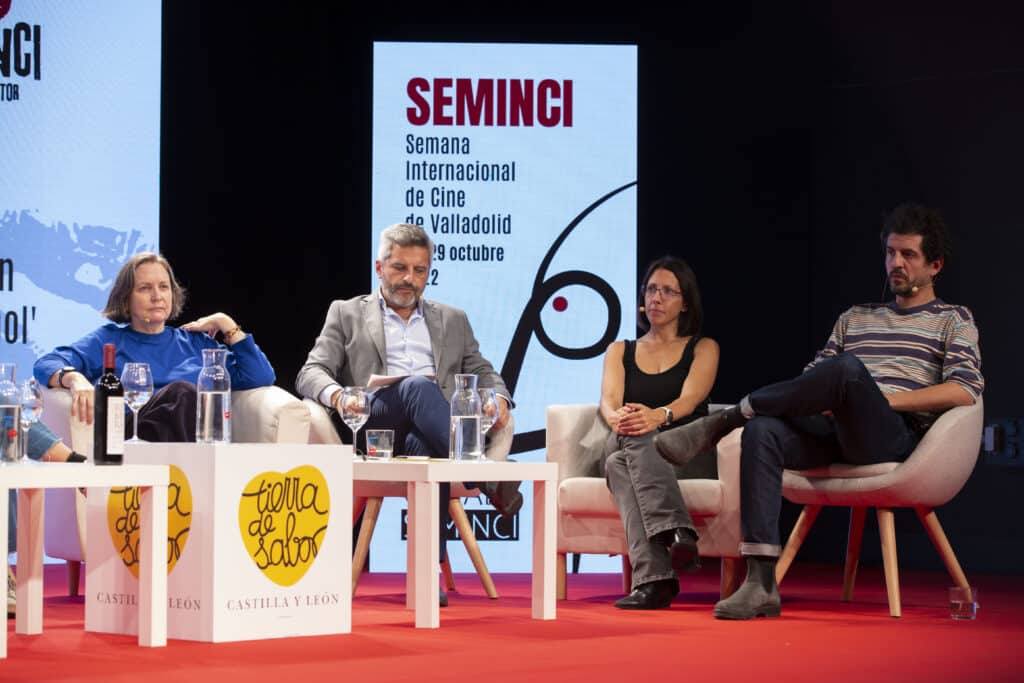The closure of cinemas due to COVID-19 has been a turning point for the film world,
which is seeking to adjust the gears of the industry to the new paradigm
After the pertinent meeting behind closed doors in the morning, the afternoon was devoted to the round table discussion of one of the most essential professional sectors of the film industry: distributors. The aim of the round table was to discuss the sector’s problems and possible solutions.
At the round table, under the moderation of the journalist, former director general of the Institute of Cinematography and Visual Arts (ICAA) and former director of the Seminci, Fernando Lara, eight representatives of the sector spoke on the same number of topics proposed by Lara, answered questions from the audience and, finally, debated the conclusions and corollaries of the morning session, which brought together almost 50 professionals from the distribution, production and exhibition
sectors.
Lara Pérez Camiña, co-president of Adicine (Association of Independent Film Distributors), spoke about independent distribution issues, defending the need for producers, distributors and exhibitors to work hand in hand from the moment a film project begins to take shape in order to achieve final success in commercial cinemas.
Álvaro Postigo, president of FECE (Federation of Spanish Cinemas), highlighted as the main idea the importance of reorganising a sector that before the pandemic, although with some bumps, was working, and after the pandemic seems to be unable to recover. “Now we are below 80,000,000 spectators, and below that figure it is not profitable to distribute”.

Too many films
He also highlighted one of the figures that has given most play to the debate: the fact that less than half of the films produced in Spain are released, an average of 200 a year. For Postigo, it is a mathematical question in which, when the number of films, the number of cinemas and the number of weeks per year are put together, it doesn’t add up: “To release everything would mean completely renewing the programme every week”.
But is it possible to set a limit on production? Who would set it? By what criteria? Are there objective markers that make it possible to anticipate which films are going to be successful and are therefore worth producing? By what authority can we limit an independent filmmaker’s desire to get his own project off the ground? Are distributors and exhibitors the main filter? These are all questions on which those present expressed their opinions, which do not always coincide.
Commercialisation through large distributors was also among the points on the agenda. As stated by Estela Artacho, president of Fedicine (Federation of Film Distributors), “the majors do not distinguish between nationalities when it comes to promoting the films they distribute; they try to do the best they can with all of them”.

Social aspects
The way in which society is changing, and therefore the way in which cinema is consumed, was also on the table. Cristina Andreu, president of CIMA (Asociación de Mujeres Cineastas y de Medios Audiovisuales, or Association of Women Filmmakers and Audiovisual Media), presented the practical case of those who want to go to the cinemas but cannot leave their children alone. “Having childcare spaces in cinemas would allow parents to go to see adult films, not just children’s films when they go with their kids,” she explained.
In the same vein, but from the other extreme, Álvaro Postigo pointed to the need to bring older people back to cinemas, who are more fearful after the pandemic.
Legislation through
Andreu also referred to the need for legislation to adapt practical measures to changing socio-economic circumstances: “Quotas, for example, have worked to bring out talent in women’s cinema. Talent must come to the fore when you start on an equal footing, but first you have to ensure that equal footing exists”.
Julio del Valle, a member of the Spanish Congress of Deputies for the PSOE, who is a member of the Culture and Sports Committee, among others, took part in the round table to provide information on legislative issues. For Del Valle, legislative measures must be accompanied by the economic resources needed to implement them. “The Cinema Act is part of the Recovery and Resilience Plans; European funds are linked to specific reforms, they are not just for the sake of it”, he explained.
Films for minority audiences
Another major focus of attention has been on films that usually have little demand and, consequently, encounter greater difficulties in terms of distribution and exhibition. Silvia Lobo, president of Próxima (Asociación de Distribuidores de Cine Independiente de Autor y en VO), explained the situation of this type of project: “The complexity stems from the number of films being made and the number of cinemas capable of showing films in their original version or documentaries, which have an even smaller audience. We cannot demand normality of premieres with three or four screenings a day because after the pandemic in cinemas there are sometimes very few spectators”.

However, Lobo herself has pointed out some solutions: “There are two ways. On the one hand, an institutional strengthening of alternative cinemas, such as film libraries, universities or museums, or cultural spaces at the local level. On the other hand, rewarding commercial cinemas that show this type of film, as well as production or distribution, for the added risk of programming these films”.
Ramiro Ledo, president of Promio (a network of independent cinemas), expressed himself in similar terms, stating that the organisation brings together cinemas that try to programme films with minimal representation in the screen quota. In this case, he highlighted the additional promotional work that they must carry out: “These cinemas usually have complements to the work of the distributors, such as loyalty programmes or their own communication actions”.
For Ledo, one of the keys lies in the absence, in Spain, of the category of art-house films, which means that there is no tool to help exhibitors with additional difficulties. “Every time there is a major technological change, such as the change from analogue to digital formats, without support policies there are entrepreneurs who cannot afford to invest in the replacement of their machinery, for example.
Debate and conclusions
After the speeches by the panel members, the attendees, most of whom are linked to the sector, contributed enriching points of view or questions to the debate. Among the burning issues were the overproduction of films and the fact that distributors act as a filter through a genuine exercise of prescription, not just selection.
The conclusions were also the subject of a pooled and nuanced debate. Finally, they were agreed upon and reflected in the final document of the conference.



























![Logo Foro Cultural de Austria Madrid[1]](https://www.seminci.com/wp-content/uploads/2024/09/Logo-Foro-Cultural-de-Austria-Madrid1-300x76.jpg)








